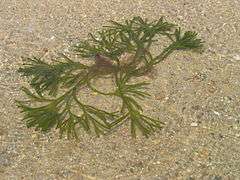Codium fragile
| Codium fragile | |
|---|---|
 | |
| Codium fragile on the Massachusetts coast | |
| Scientific classification | |
| Kingdom: | Plantae |
| Division: | Chlorophyta |
| Class: | Bryopsidophyceae |
| Order: | Bryopsidales |
| Family: | Codiaceae |
| Genus: | Codium |
| Species: | C. fragile |
| Binomial name | |
| Codium fragile (Suringar) Hariot | |
Codium fragile, known commonly as green sea fingers, dead man's fingers, felty fingers,[1] forked felt-alga, stag seaweed,[2] sponge seaweed,[3] green sponge,[4] green fleece,[5] and oyster thief,[6] is a species of seaweed in the family Codiaceae. It originates in the Pacific Ocean near Japan and has become an invasive species on the coasts of the Northern Atlantic Ocean.
This siphonous green alga is dark green in color. It appears as a fuzzy patch of tubular fingers. These formations hang down from rocks during low tide, hence the nickname "dead man's fingers".[7] The "fingers" are branches up to a centimeter wide and sometimes over 30 centimeters long.
Codium fragile occurs in the low intertidal zone, and subtidal on high-energy beaches.
It has no asexual (sporophyte) stage, and male and female gametes are both produced on separate plants.
Subspecies
Subspecies of C. fragile can only be distinguished microscopically.
Codium fragile subsp. atlanticum
Codium fragile subsp. atlanticum is known to have arrived in the southwest of Ireland around 1808. From there it may have spread by rafting or floating in the sea. Approximately 30 years later, it was found in Scotland. It is thought to have originally come from the Pacific Ocean near Japan.
Since 1840, when it was first discovered in Scotland, it has spread the entire length of Britain, including Shetland. Between 1949 and 1955 it is known to have spread between Berwick-upon-Tweed and St. Andrews, Fife, a distance of 80 km. Populations of this algae occur mostly in northern Britain. Elsewhere in Europe, it is found only in Norway.
This species displaces the native Codium tomentosum.
Codium fragile subsp. atlanticum is used as food in the Far East.[8]
_Hariot%2C_1889.jpg)
Codium fragile subsp. tomentosoides
The subspecies Codium fragile subsp. tomentosoides[9][10] (syn. Codium mucronatum var. tomentosoides), occurs along nearly the whole coastline of the eastern United States, from the Gulf of St. Lawrence in Canada to North Carolina. It is a rapidly spreading invasive species.[1] It originated in the Pacific Ocean around Japan, and was introduced into New York from Europe in 1957. Its presence was first recorded in 1964 in the Gulf of Maine at Boothbay.
This is a dominant subspecies in the subtidal zone, attaching to almost any hard surface. This results in increased maintenance labor for aquaculturists and reduces the productivity of cultured marine life. In established shellfish beds, this species can become a nuisance; it may attach to shellfish and then float away, carrying the animals with it. This was the inspiration for the common name "oyster thief".[6]
Codium fragile subsp. scandinavicum
This subspecies was introduced from Asiatic coasts of the Pacific to Norway, and to Denmark in 1919.[8]
References
| Wikimedia Commons has media related to Codium fragile. |
- 1 2 Codium fragile (Dead man's fingers, felty fingers). Intertidal Organisms EZ ID Guides. Island County Beachwatchers. Washington State University Extension. 2006.
- ↑ Invasive Species in the Pacific Northwest, P. Dee Boersma, Sarah H. Reichard, Amy N. Van Buren, 2006, ISBN 978-0-29598596-1, 208 at Google Books
- ↑ Guiry, M. D. Codium fragile (Suringar) Hariot, 1889. In: Guiry, M.D. & G. M. Guiry. (2013). AlgaeBase. National University of Ireland, Galway. Accessed through: World Register of Marine Species (WoRMS).
- ↑ Codium fragile ssp. tomentosoides (Dead Man's Fingers). Marine Invasive Species in Nova Scotia. Benthic Ecology Lab, Dalhousie University. 2001.
- ↑ Costa, J. Codium algae population explosion in Wareham. Buzzards Bay National Estuary Program.
- 1 2 Oyster Thief (Codium fragile spp. fragile). Aquatic Invasive Species. Fisheries and Oceans Canada.
- ↑ Codium fragile: Dead Man's Fingers. Monterey Bay Aquarium Research Institute. 1996.
- 1 2 Codium fragile ssp. atlanticum. Joint Nature Conservation Committee, UK.
- ↑ Codium fragile ssp. tomentosoides. Global Invasive Species Database. ISSG.
- ↑ Codium fragile ssp. tomentosoides. Introduced Species: Descriptions. MIT Sea Grant.